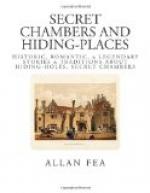Still within the military circle, a desperate dash for liberty had now to be planned. Nearly starved and reduced to the last extremity of fatigue, Charles and his guides, Glenpean and Glenaladale, crept stealthily upon all-fours towards the watch-fires, and taking advantage of a favourable moment when the nearest sentry was in such a position that their approach could be screened by the projecting rocks, in breathless silence the three stole by, and offering up a prayer for their deliverance, continued their foot-sore journey until their legs would carry them no farther.
The next four days Charles sought shelter in caves in the neighbourhood of Glenshiel, Strathcluanie, and Strathglass; but the most romantic episode in his remarkable adventures was the sojourn in the secret caves and hiding-places of the notorious robbers of Glenmoriston, under whose protection the royal fugitive placed himself. With these wild freebooters he continued for three weeks, during which time he made himself extremely popular by his freedom of intercourse with them.
The wanderer left these dwellings of comparative luxury that he might join hands with other fugitive Jacobites, Macdonald of Lochgarry and Cameron of Clunes, and took up his quarters in the wood-surrounded huts near Loch Arkaig and Auchnacarry.
The poor youth’s appearance at this period is thus described by one of his adherents: “The Prince was at this time bare-footed, had an old black kilt-coat on, philabeg and waistcoat, a dirty shirt, and a long red beard, a gun in his hand, and a pistol and dirk by his side.”
Moving again to miserable hovels in the wild recesses of the mountain Benalder, the chieftains Lochiel and Cluny acted now as the main bodyguard. The former of these two had devised a very safe hiding-place in the mountain which went by the name of “the Cage,” and while here welcome news was brought that two friendly vessels had arrived at Lochnanuagh, their mission being, if possible, to seek out and carry away the importunate heir to the Stuart throne.
The last three or four days of Charles’s memorable adventures were occupied in reaching Glencamger, halts being made on the day at Corvoy and Auchnacarry. On Saturday, September 20th, 1746, he was on board L’Heureux, and nine days later landed at Roscoff, near Morlaix.
So ended the famous escapades of the young Chevalier Prince Charles Edward.
Here is a fine field open to some enterprising artistic tourist. How interesting it would be to follow Prince Charles throughout his journeyings in the Western Highlands, and illustrate with pen and pencil each recorded landmark! Not long since Mr. Andrew Lang gave, in a weekly journal (The Sketch), illustrations of the most famous of all the Prince’s hiding-places—viz. the cave in Glenmoriston, Inverness-shire.[1] The cave, we are told, is “formed like a tumulus by tall boulders, but is clearly a




